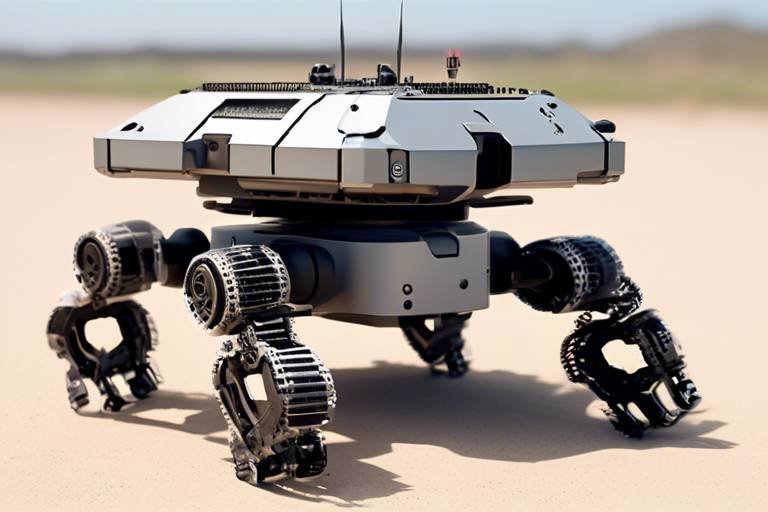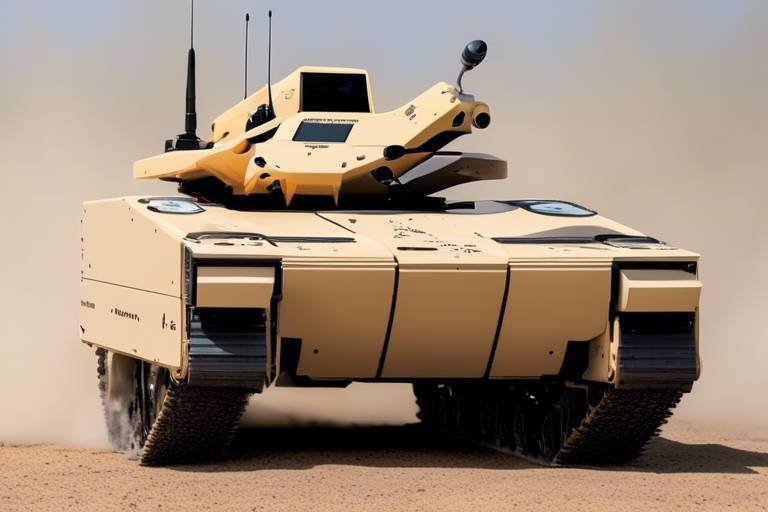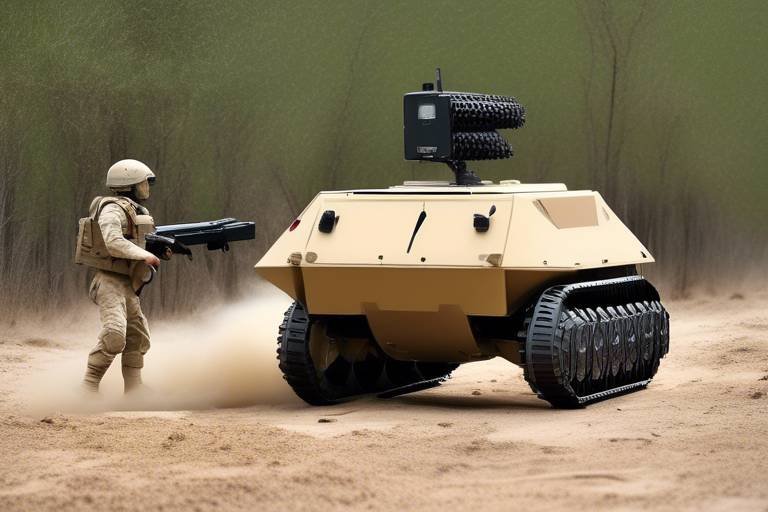Current Developments in the Robotic Systems for EOD Operations
In the ever-evolving landscape of Explosive Ordnance Disposal (EOD), the integration of robotic systems has taken center stage. These advancements are not just about flashy technology; they represent a significant leap in ensuring the safety of personnel while effectively neutralizing threats. Imagine a world where robots can navigate treacherous terrains, identify potential explosive devices, and even disarm them—all while keeping human operators at a safe distance. This is not science fiction; it is the reality of modern EOD operations.
Recent developments in robotics have introduced cutting-edge capabilities that enhance the performance of EOD systems. From improved maneuverability to increased autonomy, these innovations are crucial for operating in hazardous environments. For instance, the latest robotic systems are designed to work seamlessly in diverse terrains, whether it’s urban landscapes or rugged fields, thereby increasing operational efficiency. The robots are equipped with advanced sensors and AI-driven algorithms that allow them to make real-time decisions, which is vital when every second counts.
Moreover, the integration of artificial intelligence into these robotic systems is a game-changer. It allows robots to not only perform tasks but also to learn and adapt based on the data they collect. This means that they can identify patterns, predict potential threats, and optimize their responses to various explosive scenarios—essentially becoming smarter with every operation. In essence, the evolution of robotic systems for EOD operations is not just about enhancing capabilities; it’s about redefining the very nature of how we approach explosive threats.
As we look to the future, the trend seems to be leaning towards collaborative systems where human operators and robots work hand-in-hand. This collaboration can significantly enhance the overall effectiveness of EOD operations, ensuring that both human intuition and robotic precision are utilized to their fullest potential. The result? A safer and more efficient approach to dealing with explosive ordnance.
- What are EOD robots used for? EOD robots are primarily used to identify, locate, and neutralize explosive devices, thereby ensuring the safety of personnel and civilians.
- How do AI and machine learning enhance EOD operations? AI and machine learning allow robots to analyze data in real-time, improving their decision-making processes and enabling them to learn from past experiences.
- What safety features are integrated into EOD robotic systems? Safety features include remote operation capabilities, advanced sensors for threat detection, and fail-safe mechanisms to minimize risks during operations.
- What does the future hold for EOD robotics? The future of EOD robotics is expected to include more collaborative systems where humans and robots work together seamlessly to enhance operational effectiveness.

Advancements in Robotics Technology
Recent innovations in robotics technology have significantly enhanced the capabilities of Explosive Ordnance Disposal (EOD) systems, making them more effective and reliable in hazardous environments. Imagine a world where robots can navigate through treacherous terrains, identify threats, and neutralize explosives—all while keeping human operators at a safe distance. This is no longer a distant dream; it’s a reality being shaped by cutting-edge advancements in robotics.
One of the most notable improvements is in the area of maneuverability. Modern EOD robots are equipped with advanced mobility systems that allow them to traverse complex landscapes, whether it’s rocky terrain, urban rubble, or even underwater environments. These robots can climb stairs, navigate tight corners, and overcome obstacles that would have previously hindered EOD operations. With enhanced wheels, tracks, and even legs, these machines can adapt to various terrains, ensuring they can reach and assess explosive threats efficiently.
Moreover, precision in operations has reached new heights. The integration of high-definition cameras and sophisticated sensors enables robots to perform detailed inspections of suspicious objects. This means that instead of relying solely on human judgment, robots can now provide accurate assessments of potential threats. The ability to zoom in and capture minute details allows operators to make informed decisions without putting themselves at risk.
Another revolutionary advancement is the growing autonomy of these robotic systems. Thanks to developments in artificial intelligence, EOD robots can now operate with minimal human intervention. They can analyze their surroundings, make decisions, and execute tasks based on pre-programmed algorithms or learned experiences. This autonomy not only speeds up operations but also reduces the cognitive load on human operators, allowing them to focus on strategic aspects of the mission.
To illustrate the impact of these advancements, consider the following table that summarizes key features of modern EOD robots:
| Feature | Description |
|---|---|
| Maneuverability | Advanced mobility systems for navigating complex terrains. |
| Precision | High-definition cameras and sensors for detailed inspections. |
| Autonomy | Ability to operate with minimal human intervention. |
| Data Analysis | Real-time data processing for informed decision-making. |
In addition to these features, the integration of real-time data analytics allows EOD robots to process information on-the-fly. This capability enables them to adapt to changing situations, such as unexpected obstacles or new threats. The result is a more responsive and effective approach to explosive ordnance disposal, where robots can quickly adjust their strategies based on the environment.
In summary, advancements in robotics technology are revolutionizing EOD operations by enhancing maneuverability, precision, and autonomy. These improvements not only increase the efficiency of operations but also significantly enhance the safety of personnel involved in explosive disposal. As we continue to witness these remarkable developments, it’s clear that the future of EOD robotics is not just about machines; it’s about creating a safer world for everyone.
- What are EOD robots used for?
EOD robots are primarily used for the detection, identification, and disposal of explosive ordnance, ensuring the safety of personnel and civilians. - How do EOD robots navigate complex terrains?
They are equipped with advanced mobility systems and sensors that allow them to adapt to various environments and overcome obstacles. - What role does AI play in EOD robotics?
AI enhances decision-making capabilities, allowing robots to analyze data and adapt to dynamic situations in real-time. - Are EOD robots operated remotely?
Yes, EOD robots can be controlled from a safe distance, minimizing risks to human operators during explosive disposal operations.

Integration of AI in EOD Robotics
The integration of artificial intelligence (AI) into Explosive Ordnance Disposal (EOD) robotics is nothing short of a game-changer. Imagine a world where machines not only assist in dangerous tasks but also think and adapt like humans. This is the reality we are stepping into, as AI technologies are revolutionizing how EOD operations are conducted. By enabling machines to analyze data in real-time, these advancements allow robots to make informed decisions on the fly, which is crucial in high-pressure situations where every second counts.
One of the most remarkable aspects of AI in EOD robotics is its ability to enhance decision-making processes. Traditional methods often relied on human operators to assess situations, which could lead to delays and increased risks. However, with AI, robots can quickly evaluate their surroundings, identify potential threats, and determine the best course of action without human intervention. This level of autonomy not only improves operational efficiency but also significantly enhances safety for personnel on the ground.
At the heart of AI's impact on EOD robotics lies machine learning algorithms. These sophisticated algorithms allow robots to learn from past experiences, adapting their responses to various explosive scenarios. For instance, when a robot encounters a new type of explosive device, it can analyze the situation, learn from it, and apply that knowledge to future encounters. This continuous learning process makes EOD robots increasingly effective over time, as they become better equipped to handle diverse challenges.
Data-driven decision-making is another critical component of AI integration in EOD robotics. By leveraging vast amounts of data, these robots can improve their accuracy and reduce response times. For example, when faced with multiple potential threats, an AI-equipped robot can quickly analyze data from various sources, such as sensor inputs and historical incident reports, to determine the most immediate danger. This ability to make rapid, informed decisions can mean the difference between life and death in explosive situations.
Real-time analytics are also a significant advantage of AI in EOD operations. With the capability to provide immediate insights, operators can make quick, effective decisions during high-stakes situations. Imagine a scenario where an EOD robot is deployed to a crowded area with a suspected explosive device. The robot's AI can analyze the environment, identify potential escape routes for civilians, and relay this information to operators, enabling them to act swiftly and effectively.
Furthermore, the integration of AI has led to the development of autonomous navigation systems within EOD robots. These systems allow robots to traverse complex terrains and navigate around obstacles without human intervention. Picture a robot navigating through rubble after an explosion, using AI to assess the safest path while avoiding additional hazards. This level of operational capability not only increases efficiency but also reduces the risk to human operators, allowing them to remain at a safe distance while the robot carries out its mission.
In conclusion, the integration of AI in EOD robotics is transforming the landscape of explosive ordnance disposal. By enhancing decision-making processes, improving data-driven strategies, and enabling autonomous navigation, AI is paving the way for safer and more efficient operations. As technology continues to evolve, the future of EOD robotics looks promising, with the potential for even greater advancements that will further protect personnel and civilians alike.
- What are EOD robots? EOD robots are specialized machines designed to detect, disarm, or dispose of explosive devices safely.
- How does AI improve EOD operations? AI enhances decision-making, enables real-time analytics, and allows for autonomous navigation, improving safety and efficiency.
- What role do machine learning algorithms play in EOD robotics? Machine learning algorithms help EOD robots learn from past experiences, optimizing their responses to various explosive scenarios.
- What are the safety benefits of using EOD robots? EOD robots reduce the risk to human operators by allowing them to engage with potential explosive threats from a safe distance.

Machine Learning Algorithms
When it comes to the world of Explosive Ordnance Disposal (EOD) operations, are truly a game changer. Imagine a robot that not only reacts to threats but also learns from them—this is the kind of futuristic technology that is becoming a reality today. These algorithms enable EOD robots to analyze past incidents and adapt their strategies accordingly, much like how a seasoned detective solves cases by piecing together clues from previous investigations.
One of the standout features of machine learning in EOD robotics is its ability to enhance predictive capabilities. By processing vast amounts of data from past operations, these robots can identify patterns and anticipate potential threats. For example, if a robot encounters a specific type of explosive device in one scenario, it can learn to recognize similar devices in future encounters. This not only increases the robot’s efficiency but also significantly reduces the time it takes to neutralize threats.
Furthermore, these algorithms are designed to improve the robots' responses to various explosive scenarios. They can evaluate the effectiveness of different tactics based on real-time data, allowing for a more tailored approach in each situation. In essence, the robots become smarter and more capable with each operation, akin to how we, as humans, learn from our experiences. This learning process can be broken down into several key components:
- Data Acquisition: Gathering data from various sources, including sensors and previous missions.
- Model Training: Using this data to train machine learning models that can predict outcomes and identify threats.
- Real-Time Adaptation: Adjusting strategies on-the-fly based on new information and changing conditions.
Moreover, the integration of these algorithms into robotic systems allows for data-driven decision-making. This means that operators can rely on the insights generated by the robots to make informed decisions quickly. For instance, if a robot detects an unusual pattern in its environment, it can alert the operator, who can then assess the situation more effectively. This synergy between human operators and robotic systems is key to enhancing safety and efficiency in EOD operations.
As we look to the future, the potential applications of machine learning in EOD robotics are vast. With ongoing advancements in technology, we can expect these systems to become even more sophisticated, ultimately leading to safer and more effective explosive threat neutralization. The marriage of machine learning and robotics not only streamlines EOD operations but also holds the promise of saving lives—both of personnel in the field and of civilians in surrounding areas.
- What are machine learning algorithms?
Machine learning algorithms are computational models that enable systems to learn from data and improve their performance over time without being explicitly programmed. - How do these algorithms enhance EOD operations?
They enhance EOD operations by allowing robots to predict threats based on past experiences, adapt in real-time, and make data-driven decisions, ultimately increasing safety and efficiency. - Can robots completely replace human operators in EOD?
While robots significantly enhance EOD operations, human oversight is crucial for making complex decisions and ensuring safety in unpredictable environments.
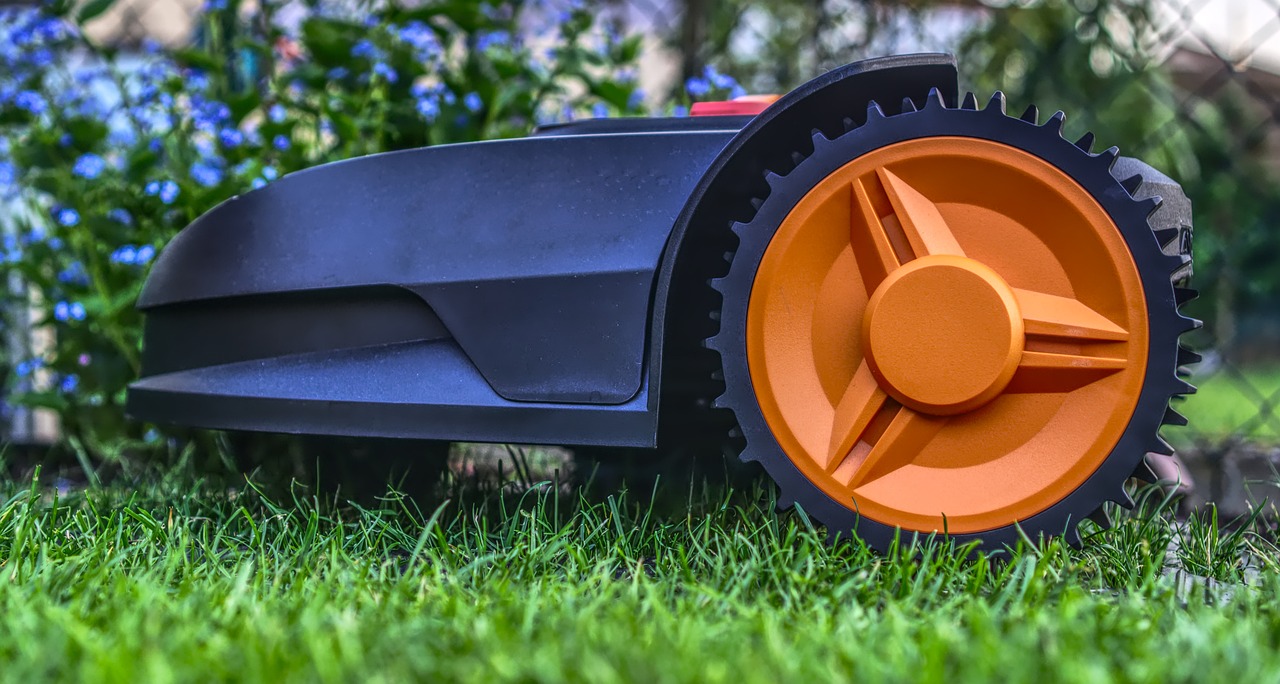
Data-Driven Decision Making
In the realm of Explosive Ordnance Disposal (EOD), the stakes are incredibly high. Every decision made can mean the difference between life and death, not just for the operators but for civilians as well. This is where becomes a game-changer. By leveraging vast amounts of data collected from various sources, EOD robots can enhance their operational effectiveness. Imagine having a personal assistant that can analyze thousands of scenarios in real-time, helping you navigate through the complexities of a hazardous environment. That’s precisely what data-driven decision making offers to EOD operations.
At its core, data-driven decision making involves utilizing real-time data to inform choices made during EOD missions. This can include everything from environmental conditions to the specific characteristics of the explosive devices being dealt with. By processing this information, robots equipped with advanced algorithms can assess risks and make informed decisions faster than any human could. For example, if an EOD robot detects a potential explosive device, it can immediately analyze the data regarding its shape, size, and location, and determine the safest method for neutralization.
Furthermore, the integration of machine learning algorithms allows these robots to continuously learn from past missions. Each operation contributes to a growing database of knowledge, enhancing their predictive capabilities. This means that over time, the robots become more adept at recognizing patterns and anticipating potential threats. It’s akin to having a seasoned veteran guiding the operations, sharing insights that can only come from experience.
Another critical aspect of data-driven decision making is the ability to conduct risk assessments. By evaluating various factors, including the likelihood of device detonation and the potential impact on surrounding areas, EOD robots can prioritize their actions. For instance, if a robot identifies a high-risk explosive device in a crowded area, it can quickly relay this information to human operators who can then make strategic decisions about evacuation or containment.
To illustrate the impact of data-driven decision making, consider the following table that summarizes key benefits:
| Benefit | Description |
|---|---|
| Increased Accuracy | Real-time data analysis leads to more precise identification and neutralization of threats. |
| Reduced Response Times | Quick access to critical information allows for faster decision-making during operations. |
| Enhanced Safety | Operators can make informed choices, reducing risks to personnel and civilians. |
| Continuous Improvement | Machine learning enables robots to refine their strategies based on past experiences. |
In conclusion, data-driven decision making is not just a buzzword in the EOD community; it’s a revolutionary approach that enhances the safety and effectiveness of operations. By harnessing the power of data, EOD robots are transforming into intelligent systems capable of making critical decisions in the face of danger. As technology continues to evolve, so too will the capabilities of these robotic systems, making them indispensable allies in the fight against explosive threats.
- What is data-driven decision making in EOD operations?
Data-driven decision making in EOD involves using real-time data to guide operational choices, enhancing the effectiveness and safety of missions. - How do EOD robots learn from past experiences?
EOD robots utilize machine learning algorithms that analyze previous missions, allowing them to improve their predictive capabilities over time. - What are the benefits of using data in EOD operations?
Benefits include increased accuracy, reduced response times, enhanced safety for personnel, and continuous improvement of operational strategies.

Real-Time Analytics
In the fast-paced world of Explosive Ordnance Disposal (EOD) operations, serve as a game changer, transforming how operators engage with potential threats. Imagine being in a high-stakes situation where every second counts, and the difference between safety and disaster hinges on the information at your fingertips. Real-time analytics provide that crucial edge, allowing EOD robots to process and analyze data instantaneously. This capability not only enhances situational awareness but also empowers operators to make swift, informed decisions that can save lives.
One of the remarkable aspects of real-time analytics is its ability to synthesize data from various sources, such as sensor inputs, environmental conditions, and historical threat data. For instance, consider an EOD robot equipped with advanced sensors that detect vibrations, heat signatures, and chemical compositions. By leveraging real-time analytics, the robot can immediately assess the threat level of an object and relay that information back to the operator. This leads to a more efficient and effective response, minimizing the risk of human error.
Furthermore, real-time analytics facilitate dynamic decision-making. As conditions change—think of a sudden shift in wind direction or unexpected obstacles appearing in the robot's path—the system can adapt its strategy on the fly. This adaptability is akin to a skilled chess player who recalibrates their moves based on the opponent's actions, ensuring that the EOD team remains one step ahead of potential dangers.
To illustrate the impact of real-time analytics in EOD operations, consider the following
| Feature | Benefit |
|---|---|
| Instant Data Processing | Enables quick assessment of threats, reducing response time. |
| Comprehensive Situational Awareness | Provides a holistic view of the environment, aiding in strategic planning. |
| Adaptive Learning | Improves the robot's performance over time by learning from past encounters. |
| Enhanced Communication | Facilitates seamless interaction between the robot and the operator, ensuring clarity in decision-making. |
In essence, the integration of real-time analytics into EOD robotics not only enhances operational efficiency but also significantly boosts safety for both personnel and civilians. By providing immediate insights and facilitating rapid decision-making, these advanced systems play a pivotal role in neutralizing explosive threats effectively. As technology continues to evolve, we can expect even more sophisticated analytics capabilities that will further revolutionize the landscape of EOD operations.
- What is the role of real-time analytics in EOD operations?
Real-time analytics help operators assess threats quickly and make informed decisions during explosive disposal operations. - How do EOD robots utilize sensor data?
EOD robots use sensor data to detect and analyze potential explosive devices, providing operators with crucial information for safe disposal. - What are the benefits of autonomous navigation in EOD robotics?
Autonomous navigation allows EOD robots to navigate complex terrains without human intervention, increasing efficiency and safety.

Autonomous Navigation Systems
The evolution of in EOD robotics is nothing short of revolutionary. Imagine a robot that can maneuver through treacherous terrains, dodging obstacles and adapting to the environment without any human input. This is not just a dream; it's a reality that is reshaping the landscape of Explosive Ordnance Disposal operations. These systems utilize a combination of advanced algorithms, sensors, and artificial intelligence to ensure that robots can navigate complex environments efficiently and safely. The ability to operate independently allows these machines to reach locations that may be too dangerous for human operators, significantly reducing the risk of injury or loss of life.
One of the key components of autonomous navigation systems is their ability to process and interpret data from various sensors. For instance, LIDAR (Light Detection and Ranging) technology enables robots to create detailed 3D maps of their surroundings. This capability is essential in environments where visibility is compromised, such as during a dust storm or in low-light conditions. Additionally, GPS technology provides crucial location tracking, allowing robots to maintain their bearings even in challenging terrains. These systems work in tandem to create a comprehensive understanding of the robot's environment, enabling it to make informed decisions on the fly.
Moreover, the integration of machine learning algorithms enhances the robot's ability to learn from its experiences. For example, if a robot encounters an unexpected obstacle, it can analyze the situation and adjust its navigation strategy accordingly. This adaptability is vital in EOD operations, where the landscape can change rapidly due to various factors, including weather conditions and the presence of explosives. As these systems continue to evolve, we can expect even greater levels of autonomy, allowing robots to operate effectively in more complex scenarios.
To illustrate the capabilities of autonomous navigation systems, consider the following table that highlights some of the technologies and their functions:
| Technology | Function |
|---|---|
| LIDAR | Creates detailed 3D maps for navigation |
| GPS | Provides location tracking and navigation support |
| Machine Learning | Enables robots to learn from experiences and adapt |
| Obstacle Detection Sensors | Identifies and avoids obstacles in real-time |
In conclusion, the advancements in autonomous navigation systems are a game changer for EOD operations. By enhancing the robots' ability to navigate complex environments independently, these systems not only improve operational efficiency but also significantly enhance safety for personnel involved in explosive disposal. The future of EOD robotics looks promising, with ongoing research and development aimed at pushing the boundaries of what these machines can achieve.
- What are autonomous navigation systems?
Autonomous navigation systems are technologies that allow robots to navigate and operate independently in various environments without human intervention. - How do EOD robots avoid obstacles?
EOD robots use a combination of sensors, including LIDAR and obstacle detection sensors, to identify and navigate around obstacles in their path. - What role does machine learning play in EOD robotics?
Machine learning algorithms help EOD robots learn from past experiences, allowing them to improve their decision-making and navigation strategies over time. - Are autonomous EOD robots safe to use?
Yes, autonomous EOD robots are designed with safety in mind, utilizing advanced technologies to minimize risks to human operators during explosive disposal operations.

Safety Enhancements in EOD Robotics
In the high-stakes world of Explosive Ordnance Disposal (EOD), safety is not just a priority; it’s a necessity. Recent advancements in robotic systems have been pivotal in enhancing safety measures, ensuring that both personnel and civilians are protected during operations. These innovations focus on several key areas, including remote operation capabilities, advanced sensor technologies, and fail-safe mechanisms. Each of these enhancements plays a crucial role in minimizing risks associated with explosive threats.
One of the most significant safety enhancements is the development of remote operation capabilities. This technology allows EOD robots to be controlled from a safe distance, effectively keeping human operators out of harm's way. Imagine being able to disarm a bomb while sitting comfortably behind a barricade; that’s the kind of safety remote operations provide. Operators can engage with potential explosive threats without physically being present at the site, significantly reducing the risk of injury or fatality.
Moreover, advanced sensor technologies have transformed how EOD robots detect and identify explosive devices. Utilizing tools like LIDAR (Light Detection and Ranging) and thermal imaging, these robots can gather critical information about their surroundings and the objects within them. This capability not only enhances detection rates but also improves the accuracy of identifying threats. For instance, LIDAR can create detailed 3D maps of the environment, allowing operators to spot explosive devices hidden beneath debris or foliage. With such advanced sensors, the chances of missing a threat are dramatically reduced, making operations safer for everyone involved.
Another crucial aspect of safety enhancements in EOD robotics is the implementation of fail-safe mechanisms. These systems are designed to ensure that if something goes wrong—be it a technical failure or a loss of communication—the robot can still perform a safe shutdown or retreat. This is akin to having a safety net in a high-wire act; it provides an additional layer of security that can prevent catastrophic failures. By incorporating these fail-safe features, manufacturers are ensuring that EOD robots can operate reliably in unpredictable and dangerous environments.
In addition to these technological advancements, training and simulation play vital roles in enhancing safety. Operators are now trained using virtual reality (VR) and augmented reality (AR) simulations that mimic real-life scenarios. This allows them to practice their responses to various explosive threats without any risk. As they gain experience in these controlled environments, their confidence and decision-making skills improve, which translates to safer operations in the field.
To summarize, the safety enhancements in EOD robotics are a game-changer. By focusing on remote operation capabilities, advanced sensors, fail-safe mechanisms, and comprehensive training, the field of EOD is becoming increasingly safer. With these innovations, we can expect not only improved operational efficiency but also a significant reduction in risks to human life during explosive disposal operations.
- What are the main safety features of EOD robots?
The main safety features include remote operation capabilities, advanced sensor technologies, and fail-safe mechanisms that ensure safe operations in hazardous environments. - How do advanced sensors improve the safety of EOD operations?
Advanced sensors like LIDAR and thermal imaging allow EOD robots to detect and identify explosive devices more accurately, reducing the likelihood of missing a threat. - What role does training play in enhancing safety for EOD operators?
Training using VR and AR simulations helps operators practice in controlled environments, improving their skills and confidence, which leads to safer operations in real-life scenarios.

Remote Operation Capabilities
The evolution of robotic systems for Explosive Ordnance Disposal (EOD) operations has led to remarkable advancements in . These innovations are not just about convenience; they are fundamentally reshaping how we approach safety in hazardous environments. Imagine being able to control a robot from hundreds of meters away, effectively keeping operators out of harm's way while still engaging with potential threats. This capability is crucial, especially in situations where every second counts.
Remote operation allows EOD robots to be utilized in dangerous scenarios without putting human lives at risk. Operators can control these machines using sophisticated interfaces that provide real-time feedback and visual data. This is akin to playing a video game where the stakes are immensely higher—your actions can mean the difference between life and death. The ability to maneuver a robot remotely ensures that operators can assess and neutralize threats without being physically present in the line of fire.
Moreover, the technology behind remote operation is becoming increasingly sophisticated. Many EOD robots are equipped with high-definition cameras and advanced communication systems that allow operators to receive detailed visual and auditory information. This real-time data stream is essential for making informed decisions quickly. For instance, operators can analyze the layout of a site, identify potential hazards, and plan their next steps without ever stepping foot into a dangerous area.
One of the key features of remote operation is the use of teleoperation systems. These systems often include:
- High-definition cameras for real-time visual feedback.
- Robust communication links to ensure uninterrupted control and data transmission.
- Intuitive control interfaces that mimic the natural movements of operators.
As the technology continues to develop, we can expect even more enhancements in remote operation capabilities. Future EOD robots may incorporate augmented reality (AR) features, allowing operators to visualize data overlays on their screens, providing context to the environment they are navigating. This could lead to more precise actions and quicker responses in critical situations.
In summary, remote operation capabilities are not just a technological advancement; they represent a significant leap forward in ensuring the safety of EOD personnel. By allowing operators to engage threats from a distance, we are not only protecting human lives but also enhancing the efficiency and effectiveness of explosive ordnance disposal operations. The future looks bright, and as we continue to innovate, we can anticipate even safer and more reliable EOD robotic systems.
- What is the primary benefit of remote operation capabilities in EOD robotics?
Remote operation capabilities primarily enhance safety by allowing operators to control robots from a safe distance, minimizing the risk to human life during explosive disposal operations. - How do remote operation systems work?
These systems use advanced communication technologies that allow operators to send commands and receive real-time feedback from the robot, often equipped with high-definition cameras and sensors. - Will future EOD robots have more advanced remote capabilities?
Yes, future developments may include features like augmented reality for enhanced situational awareness and improved decision-making during operations.
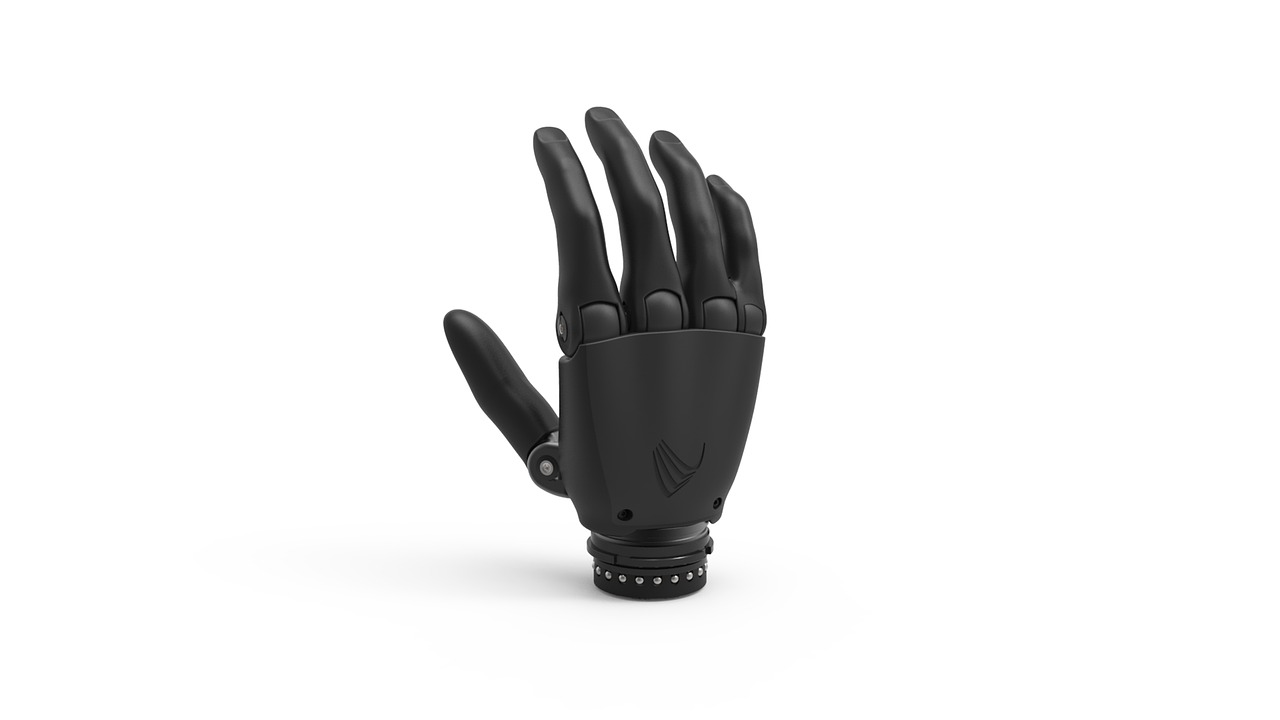
Advanced Sensor Technologies
In the realm of Explosive Ordnance Disposal (EOD), are not just luxuries; they are essential tools that redefine how we approach the detection and neutralization of explosive threats. Imagine a world where robots can "see" and "feel" their environment with unparalleled precision, allowing them to identify potential dangers before they escalate. This is the reality that advanced sensors are creating in EOD operations.
One of the most groundbreaking technologies in this field is LIDAR (Light Detection and Ranging). By emitting laser beams and measuring the time it takes for them to return, LIDAR can create detailed 3D maps of the terrain. This capability is crucial for EOD robots as they navigate complex environments, allowing them to identify obstacles and potential hazards with remarkable accuracy. In addition to LIDAR, thermal imaging sensors play a pivotal role in detecting explosives that may not be visible to the naked eye. These sensors can identify heat signatures, which is particularly useful in locating buried explosives or identifying devices that have been recently activated.
Furthermore, the integration of chemical sensors enhances the robots' ability to detect specific explosive compounds. These sensors can sniff out traces of explosives in the air, providing crucial information that can prevent catastrophic incidents. The combination of these advanced sensor technologies allows EOD robots to operate in a variety of environments, from urban landscapes to remote areas, ensuring that they can handle any situation that may arise.
To illustrate the impact of these technologies, let's take a look at a comparison of traditional detection methods versus advanced sensor technologies:
| Detection Method | Advantages | Limitations |
|---|---|---|
| Traditional Metal Detectors | Simple to use, cost-effective | Limited to metallic objects, prone to false positives |
| LIDAR | Creates detailed 3D maps, identifies obstacles | Requires clear line of sight, affected by weather conditions |
| Thermal Imaging | Detects heat signatures, useful in low visibility | Can be expensive, may require extensive training |
| Chemical Sensors | Detects specific explosive compounds | Can be sensitive to environmental factors, may require calibration |
The evolution of these technologies not only enhances the efficiency of EOD operations but also significantly increases safety for both personnel and civilians. By equipping robots with advanced sensors, we reduce the need for human operators to be in close proximity to potential explosive devices, thereby minimizing risks. As these technologies continue to advance, we can expect even greater improvements in detection capabilities, leading to safer and more effective EOD operations.
- What is the role of LIDAR in EOD operations? LIDAR helps create detailed 3D maps of the terrain, allowing EOD robots to navigate complex environments safely.
- How do thermal imaging sensors improve safety? They detect heat signatures, which can help locate hidden explosives, especially in low visibility conditions.
- What are chemical sensors used for in EOD robotics? These sensors detect specific explosive compounds, providing crucial information for threat assessment and neutralization.
- Are advanced sensors expensive? While they can be costly, the increased safety and efficiency they provide often justify the investment.

Future Trends in EOD Robotics
The landscape of Explosive Ordnance Disposal (EOD) is rapidly evolving, and the future of EOD robotics is nothing short of fascinating. As technology advances, we are witnessing a shift towards more collaborative systems where human operators and robots work together seamlessly. This integration not only enhances the effectiveness of operations but also significantly improves the safety of personnel involved in these high-stakes missions. Imagine a world where robots can handle the most dangerous tasks while humans oversee and make critical decisions from a safe distance—this is the future we are heading towards.
One of the most exciting trends is the development of swarm robotics. Inspired by the behavior of social insects like ants and bees, swarm robotics involves multiple robots working in unison to tackle complex tasks. In EOD operations, this could mean deploying several small robots to cover a wide area, share information, and coordinate their actions to neutralize threats more effectively. The potential for increased efficiency is enormous, as these robots can communicate and adapt to changing conditions in real time.
Moreover, as machine learning and AI continue to advance, future EOD robots will become even more autonomous. They will be capable of learning from past missions, understanding patterns in explosive layouts, and predicting potential threats based on historical data. This capability will not only enhance their operational effectiveness but will also allow them to make decisions without waiting for human input, thus speeding up response times in critical situations.
Another trend is the enhancement of human-robot interaction. Future EOD systems will likely feature intuitive interfaces that allow operators to control robots with minimal training. Imagine using gestures or voice commands to direct a robot while maintaining full situational awareness. Such advancements will make it easier for operators to engage with robotic systems, especially in high-pressure environments where every second counts.
Furthermore, the integration of augmented reality (AR) into EOD operations is on the rise. AR technology can provide operators with real-time data overlays, allowing them to visualize the environment and the robot's status more effectively. For instance, an operator could see a 3D map of the area with highlighted threats and robot positions, making it easier to strategize and execute missions.
As we look ahead, it’s essential to consider the implications of these advancements. While the benefits of improved safety and efficiency are clear, there are also challenges to address, such as ethical considerations and the need for robust cybersecurity measures to protect these systems from potential threats. The collaboration between humans and robots in EOD operations will require ongoing research and development to ensure that these technologies are safe, reliable, and effective.
In summary, the future of EOD robotics is bright and filled with potential. As we embrace these trends, we can look forward to a new era of explosive ordnance disposal that prioritizes safety, efficiency, and collaboration. The integration of advanced technologies will not only transform how we approach EOD operations but also redefine the roles of human operators and robots in this crucial field.
- What are the main benefits of using robotics in EOD operations?
Robotics in EOD operations enhances safety by allowing operators to engage with threats from a distance, improves efficiency through automation, and provides advanced capabilities for detection and neutralization of explosives.
- How will AI change the future of EOD robotics?
AI will enable EOD robots to learn from past experiences, make real-time decisions, and adapt to dynamic environments, significantly improving their effectiveness in neutralizing threats.
- What role will human operators play in future EOD operations?
Human operators will oversee robotic actions, make critical decisions, and ensure the safety of operations while benefiting from enhanced interfaces and real-time data provided by advanced technologies.
Frequently Asked Questions
- What are the latest advancements in EOD robotics?
The latest advancements in EOD robotics include enhanced maneuverability, precision, and autonomy, thanks to innovations in robotics technology. These improvements allow robots to operate more effectively in hazardous environments, increasing safety for personnel and operational efficiency.
- How is AI integrated into EOD robotics?
Artificial intelligence is revolutionizing EOD robotics by enabling machines to analyze data in real-time and adapt to dynamic situations. This integration enhances decision-making processes, allowing robots to neutralize threats more effectively.
- What role do machine learning algorithms play in EOD operations?
Machine learning algorithms improve the predictive capabilities of EOD robots, allowing them to learn from past experiences. This capability optimizes their responses to various explosive scenarios, making them more effective in the field.
- How do autonomous navigation systems benefit EOD robots?
Autonomous navigation systems enable EOD robots to traverse complex terrains and navigate obstacles without human intervention. This feature significantly enhances their operational capabilities and efficiency during missions.
- What safety enhancements are implemented in EOD robotics?
Safety enhancements include remote operation capabilities, advanced sensors, and fail-safe mechanisms. These innovations are critical for protecting personnel and civilians during explosive disposal, minimizing risks associated with EOD operations.
- How do advanced sensor technologies aid EOD robots?
Advanced sensor technologies, such as LIDAR and thermal imaging, improve the detection and identification of explosive devices. This allows EOD robots to operate more effectively in various environments, ensuring a higher success rate in neutralizing threats.
- What are the future trends in EOD robotics?
Future trends suggest a movement towards more collaborative systems, where human operators and robots work together seamlessly. This collaboration aims to enhance the overall effectiveness and safety of explosive ordnance disposal operations.





